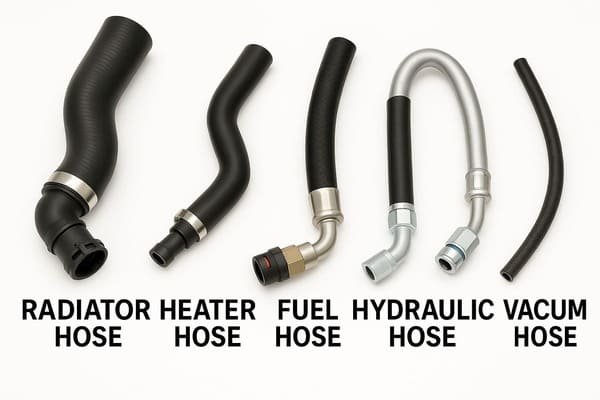Cars fail when seals fail. Fluids leak. Noise grows. Time and money go fast. I solve this with the right rubber, matched to the job, from design to PPAP.
Automotive rubber is not one material. Most parts use families: EPDM for weather and coolant, NBR/HNBR/ACM/AEM for oils, FKM for fuels and heat, VMQ/FVMQ for extreme temperature, and CR/SBR/NR for mounts and tires.

I run a factory, so I see the same problem often. A wrong compound adds noise, leaks, and warranty cost. The fix is simple. Match application → medium → temperature → hardness → standard.
What are the main automotive rubber types?
Buyers hear many acronyms and get stuck. I keep it simple and group by job.
Automotive rubbers fall into six buckets: weather sealing (EPDM), oil systems (NBR/HNBR/ACM/AEM), fuel and high heat (FKM), high/low temp and elastomeric comfort (VMQ/FVMQ), vibration and tires (NR/SBR), and legacy general use (CR).
The landscape at a glance
✅ I use a short table first, then dive deeper.
🛠️ Use it to shortlist materials before drawings.
| Family | Typical Use | Temp Range (°C) | Key Strengths | Watch-outs | Relative Cost |
|---|---|---|---|---|---|
| EPDM1 | Weatherstrips, radiator hoses | -50 ~ +150 | Ozone, water, steam | Poor oil/fuel | $ |
| NBR2 | Oil seals, sump gaskets | -30 ~ +120 | Oil, diesel | Ozone aging | $ |
| HNBR3 | A/C, timing covers, belts | -30 ~ +150 | Hot oil, strength | Cost vs NBR | $$ |
| AEM (Vamac)4 | ATF hoses, turbo air | -40 ~ +150 | Oil, heat, flex | Fuel aromatics | $$ |
| ACM5 | Transmission seals | -20 ~ +150 | ATF, heat | Low low-temp | $$ |
| FKM (Viton®)6 | Fuel rails, turbo hoses | -20 ~ +200 | Fuel, heat | Price, low-temp set | $$$ |
| VMQ (Silicone)7 | Turbo boots, EV pack seals | -60 ~ +200 | Temp, clean surface | Tear, fuels | $$–$$$ |
| FVMQ8 | Sensors, turbo near hot zones | -60 ~ +230 | Temp + fuels | Price | $$$ |
| CR (Neoprene)9 | Legacy boots, mounts | -35 ~ +110 | Weather, moderate oil | Fuel blends | $ |
| NR/SBR10 | Tires, mounts, bushings | -40 ~ +90 | Fatigue, damping | Ozone, oil | $ |
Why this grouping works
- I match media first: water/steam vs oil vs fuel vs refrigerant.
- I check continuous and peak temperatures.
- I set hardness to fit squeeze and movement.
- I confirm standards (ASTM D200011/SAE J200), PPAP12, and RoHS/REACH13.
- I validate with a sample run and a life test.
Why is EPDM the default for weatherstrips and cooling hoses?
Doors rattle when a seal hardens. Radiator hoses crack when ozone wins. EPDM stops that.
Automakers choose EPDM for weather, water, and coolant because it resists ozone, UV, steam, and glycols, while staying flexible for years. It is cost-effective and stable in outdoor cycles.

EPDM in real automotive life
I supply window channels, door seals, and radiator hoses. I see EPDM survive heat-soak, winter freeze, and car-wash cycles. It keeps compression set low and blocks noise and water ingress.
What makes EPDM fit?
- ✅ Ozone and UV resistance keeps the skin intact.
- ✅ Glycol and water resistance suits coolant circuits.
- ✅ Stable compression set holds door closing force.
- ✅ Wide temp works from alpine cold to desert sun.
- 🛠️ Easy to extrude or mold; splicing is reliable.
EPDM selection notes
| Parameter | Typical Range | Why it matters |
|---|---|---|
| Shore A hardness | 50–80 ShA | Softer for weatherstrips, harder for hoses |
| Density | 1.10–1.20 g/cm³ | Impacts weight and cost |
| Cure system | Peroxide/Sulfur | Peroxide improves heat/steam resistance |
| Reinforcement | Carbon black/white filler | Controls strength and surface finish |
| Tolerance | ISO 3302-1 M2–M3 | Controls fit in long extrusions |
Where EPDM is not right
- Oils and fuels swell EPDM fast. I do not use it for crankcase or fuel rails.
- If low compression force is critical in deep winter, silicone may be better.
What rubber works with oil and fuels?
Engines breathe hot oil mist and fuels with ethanol or aromatics. Wrong rubber swells, softens, and leaks.
Use NBR for general oils, HNBR for hot oils and strength, ACM/AEM for ATF and under-hood heat, and FKM for modern fuels and high temperature.

Oils first, fuels second
I separate engine oils and transmission fluids from gasoline and diesel. Ethanol, biodiesel, and additives change the picture.
Quick media compatibility guide
| Media | Good | Better | Best | Avoid |
|---|---|---|---|---|
| Engine oil | NBR | HNBR | FKM | EPDM |
| ATF | AEM/ACM | HNBR | FKM | EPDM |
| Diesel (B0–B7) | NBR | HNBR | FKM | EPDM |
| Gasoline (E0–E10) | HNBR | FKM | FKM | EPDM, VMQ |
| Biofuels (higher ethanol/biodiesel) | HNBR | FKM | FKM | EPDM, NR |
Design realities I check
- Swelling: I limit volume change to <10% after immersion at temperature.
- Permeation: I measure fuel vapor loss on thin sections in rails and canisters.
- Compression set14: I aim for low set at both 23 °C and operating temp.
- Tear and abrasion: Dynamic seals and diaphragms need higher tear strength.
Typical hardness by part
| Part | Hardness (Shore A) | Reason |
|---|---|---|
| Static sump gasket (NBR) | 65–75 | Seal under bolt load without creep |
| ATF hose (AEM) | 70–80 | Pressure + heat + flex |
| Fuel rail O-ring (FKM) | 75–90 | Extrusion resistance and permeation control |
| A/C O-ring (HNBR) | 70–80 | PAG oil + refrigerant + pressure |
What rubber handles high temperature under the hood?
Heat kills elastomers fast. Turbo zones and manifolds need special choices.
FKM, VMQ, and FVMQ handle high continuous temperatures; HNBR and AEM cover most hot-oil and hot-air zones. I choose by peak temperature, dwell time, and fuel exposure.
Temperature bands that matter
I design for continuous and peak temperature, not catalog “max”. I add safety margins for soak-back after engine stop.
| Material | Continuous (°C) | Peak (°C) | Typical Use |
|---|---|---|---|
| HNBR | 140–150 | 160–170 | A/C, timing covers, hot oil seals |
| AEM | 140–150 | 160–175 | Turbo air, ATF hoses |
| ACM | 140–150 | 160 | Transmission seals |
| FKM | 180–200 | 220–230 | Fuel rails, turbo vicinity |
| VMQ | 180–200 | 220 | Charge-air boots, EV pack seals |
| FVMQ | 200–230 | 240 | Sensors near turbo, hot fuel splash |
Hidden traps
- Hot fuel splash: VMQ handles heat but not fuels; I swap to FKM/FVMQ in mixed exposure spots.
- Low-temp sealing: FKM can be stiff in deep winter; an FKM low-temp grade or HNBR may seal better at -30 °C.
- Compression set: I target formulations with improved set at both edges of the range.
Practical life testing I run
- Heat-aging for 70–168 hours at target temp, then tensile/elongation and set.
- Fluid immersion15 in oils, fuels, and refrigerants at temperature.
- Pressure-pulse for hoses; shaker + temperature for mounts.
How do I select rubber for a new automotive seal?
Too many choices slow projects. I use a fixed sequence and close fast.
I map media, temperature, movement, and assembly, then pick 2–3 candidate compounds and validate with ASTM D2000 callouts, drawings, and a short life test.
My 6-step selection playbook
- Define media: water/glycol, oils, fuels, refrigerants, road splash.
- Define temperature: continuous and peak, include soak-back.
- Set mechanics: static vs dynamic, squeeze %, gap, durometer.
- Set standards: ASTM D2000 line callout, PPAP level, IMDS.
- Prototype: samples in 2–3 compounds, validate fit and force.
- Verify: lab tests, then on-bench endurance.
Useful tables
| Criterion | Target | Why |
|---|---|---|
| Durometer16 | ±5 ShA of spec | Controls clamp load and sealing line |
| Compression set | <25% at use temp | Keeps sealing force over life |
| Swell in media | <10% | Maintains dimension and hardness |
| Tensile/elongation17 | ≥8 MPa / ≥200% (typical) | Basic robustness |
| Tolerance class18 | ISO 3302-1 M2/M3 | Predictable assembly fit |
Standards buyers ask me for
- ASTM D2000 / SAE J200 line callout on drawings.
- IATF 1694919 quality system, PPAP, APQP, and control plans.
- RoHS/REACH compliance and IMDS entries for materials.
- FMVSS 302 for interior flammability when relevant.
- Leak and pressure tests for hoses and pack gaskets (IP6x/7x targets for EV packs).
✅ I prepare the PPAP package and 8D formats when you need them.
🛠️ I design and cut molds in-house to compress lead time.
What about EVs: do batteries change rubber choices?
EV packs push new sealing needs: water-tight, dust-tight, and clean chemistry near cells.
For battery enclosures I use VMQ for temperature swing and clean compression, or EPDM for cost and environmental resistance. For coolant circuits I use EPDM/VMQ; for sensor seals near inverters I use FKM/FVMQ.

Pack sealing lessons from projects
- Ingress: I target at least IP66 for road splash; many OEMs ask IP67/68.
- Compression set: Large gaskets need controlled hardness and foam variants to even out clamping.
- Chemistry: I avoid outgassing that can fog optics or sensors.
| EV Area | Recommended Rubber | Reason |
|---|---|---|
| Pack perimeter gasket20 | VMQ or EPDM | Thermal swing, water ingress |
| Coolant quick connectors21 | EPDM | Glycol water + pressure |
| HV inverter sensor O-rings22 | FKM/FVMQ | Heat + fluid exposure |
| Vent membranes (frame gaskets)23 | VMQ | Permeation control + temp |
Conclusion
Automotive rubber selection is a system decision. Start with media and temperature. Confirm hardness and standards. Validate fast with samples and tests.
Ready to spec your seal or hose?
I am Kelly at Julong Rubber (B2B, factory direct). Send drawings, media, and temperature, and I will shortlist materials and quote fast.
- 📧 info@rubberandseal.com
- 🌐 www.rubberandseal.com
- 💬 Or reach out to us directly via WhatsApp:

-
Explore how EPDM's properties make it ideal for weatherstrips and hoses, ensuring durability and flexibility. ↩
-
Learn about NBR's effectiveness in oil seals and gaskets, and its resistance to various oils. ↩
-
Discover why HNBR is preferred for high-temperature applications and its strength in automotive components. ↩
-
Find out how AEM's properties make it suitable for ATF hoses and turbo air applications. ↩
-
Understand ACM's role in transmission seals and its performance under heat. ↩
-
Explore FKM's high-temperature resistance and its suitability for modern fuel applications. ↩
-
Learn how VMQ handles extreme temperatures and its use in EV pack seals. ↩
-
Discover FVMQ's advantages in sensors and turbo areas, especially under heat. ↩
-
Find out how CR rubber is effective for legacy boots and mounts due to its weather resistance. ↩
-
Learn about NR/SBR's applications in tires and mounts, focusing on fatigue and damping. ↩
-
Learn about ASTM D2000 standards and their significance in rubber material selection. ↩
-
Understanding PPAP is crucial for ensuring quality and compliance in automotive production, making it a must-read for industry professionals. ↩
-
Understanding RoHS and REACH is crucial for compliance in automotive manufacturing, ensuring safety and environmental standards. ↩
-
Understand how compression set impacts the longevity and performance of rubber seals. ↩
-
Find out how fluid immersion tests ensure the durability of rubber in automotive applications. ↩
-
Understanding durometer is crucial for ensuring optimal sealing performance and longevity in various applications. ↩
-
Understanding tensile and elongation properties is crucial for ensuring the robustness and durability of rubber seals in various applications. ↩
-
Understanding tolerance class is crucial for ensuring predictable assembly fit and product reliability. ↩
-
Explore this resource to understand IATF 16949's role in enhancing automotive quality and compliance. ↩
-
Explore this link to understand the critical role of pack perimeter gaskets in EVs, ensuring thermal stability and water ingress protection. ↩
-
Explore this link to discover optimal materials and designs for coolant quick connectors, ensuring reliability and performance in EVs. ↩
-
Explore this resource to understand the critical role of HV inverter sensor O-rings in EVs, ensuring reliability and performance. ↩
-
Explore this link to understand the critical role of vent membranes in EVs, ensuring optimal performance and safety. ↩








